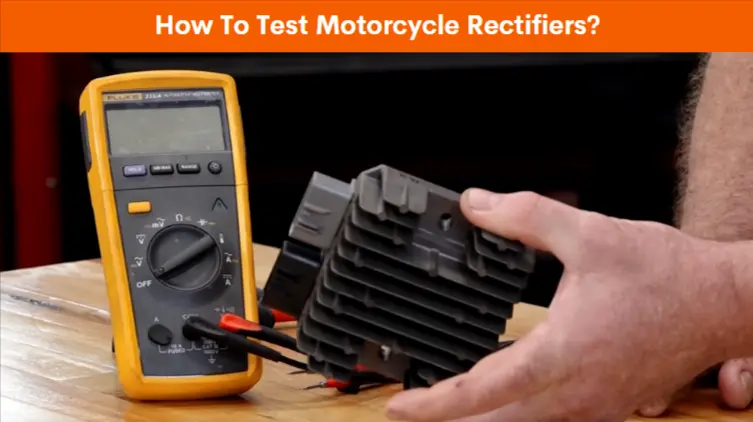Are you also looking for “How To Test Motorcycle Rectifiers?“
If your answer is Yes, then this blog will help you.
A durable and unbreakable two-wheeler depends on a working motorbike rectifier regulator. A motorcycle’s condition affects its market value and performance on the road. Manufacturers have built rectifiers to last a lifetime with this in mind.
However, this component may become defective and necessitate testing due to factors like temperature and riding habits.
Here, in this blog, we will discuss in detail “How To Test Motorcycle Rectifiers?“
Table of Contents
How to Test Motorcycle Rectifiers?
You would not want a weak, dead, or overloaded battery, which is what a malfunctioning motorcycle rectifier regulator frequently causes.
Therefore, rule out your theories by completing a motorbike rectifier test, as explained in this section, if you observe that your headlights are flickering or burning out quickly at higher RPMs. Here, we will discuss the Motorcycle Rectifier test in eight steps.
Step1: Make sure that your battery is full –
Perform this test after making sure your battery is full. In addition, your bike ought to be idle.
Step 2: Verify the voltage in an open circuit.
Set your multimeter to read volts DC and then check the battery’s open-circuit voltage before attaching the positive and negative leads to the appropriate battery terminals. You should receive a reading from the battery between 12.5 and 12.9 volts DC.
Step3: Boost the engine
Upshift to 5,000 RPM. Consult your owner’s manual for instructions, as some OEMs require 1,500 RPM.
Step 4: Perform a test on the DC voltage regulator.
Similar to step #2, test the battery terminals. The voltmeter/multimeter should display a reading between 13.2 volts DC and 14.8 volts DC if the rectifier regulator on your motorcycle is operating correctly.
Note: Readings less than this range or the OEM-specified values indicate a charging system malfunction with the rectifier regulator as the likely cause.
Readings over this range or values set by the OEM may indicate that your motorcycle operates much outside its tolerance zone and is saturating the battery and charging system. The bike’s battery and any voltage-sensitive components are sure to sustain harm when this occurs.
Step 5: Test the voltage drop.
Consider verifying the charging system’s components if voltage readings are outside the 13.2 to 14.8-volt DC range.
Prepare for the possibility that your voltage regulator needs to be replaced for 16 volts DC or higher readings.
- Set the voltmeter to 2 volts.
- Laid the engine at rest.
- Check the voltage across the connectors and individual wires of the charging system.
- Look for damaged, corroded, or loose cables if there are more than 0.2 volts in any connection or wire.
- When repairing relations, look for no more than 0.1 volts of voltage drops.
The voltage above drop requirements must be met since high resistance in the charging system circuit of your motorcycle significantly lowers current flow.
Additionally, it prevents sufficient electricity from getting to various components of the charging system, hurting the motorcycle’s operation.
Step6: Circumvent the regulator
Another technique to see if the regulator in your motorcycle rectifier or another element of the charging system is broken is a regulator bypass test. However, the process cannot be generalized because each motorbike has a unique charging system setup.
Furthermore, the voltage regulator can be connected to the circuit’s ground or power side.
NOTE –
Ensure that all electrical accessories are turned off before starting.
As soon as the multimeter detects a charging voltage, disconnect your jumper wires.
Ensure that the engine is turned off.
The voltage output should be observed. If it is at the highest setting, your regulator has been tampered with and is, therefore, not the problem. Your regulator can be faulty if everything is normal.
Step 7: Verify for Potential Diode Leaks.
Switch your voltmeter or multimeter to the AC voltage scale and take voltage readings while the motor is still operating to check for this leak. Contrary to the previous steps, however, connect the negative (black) line to the battery’s negative terminal, and the positive (red) lead to the B+ connector on the back of the alternator.
At this step, you are performing a diode test, checking each diode’s forward and reverse bias to see if they allow or prevent the passage of electricity appropriately.
Step 8: Test the motorcycle rectifier.
The DC voltage test determines how efficiently your battery is being charged and generally confirms if there is a problem with your motorcycle rectifier regulator.
However, readings from the voltage test alone would not be adequate because the latter is dual-functional. As a result, you will need to evaluate each of its two components independently, which entails assessing the motorbike rectifier block alone.
Conclusion –
After reading this blog, now you can know “How To Test Motorcycle Rectifiers?” This blog will help you, you can get your desired answer, and you get successful in testing the Motorcycle Rectifier.
Frequently Ask Questions (FAQs)-
-
How can I tell if the motorbike rectifier is defective?
Poor starts, erratic meter readings, and dimmed headlights are warning flags you’ll notice immediately. The bike will start to draw battery power at about 13 volts. It will be soon that the engine shuts off when this occurs.
-
Can a malfunctioning rectifier make a motorcycle run?
In a simple sentence you can say that Yes. The battery may drain if the charging mechanism malfunctions due to the malfunctioning rectifier. A faulty voltage regulator may result in the battery being overcharged, which could ‘kill’ the battery.
-
Can you operate a motorcycle without a rectifier?
Running without an active rectifier won’t harm anything. The problem is that you’ll have a minimum operating range, which means the engine could shut off at any point. Usually, this will happen when you’re coming to a halt at idle rather than when you’re traveling under load.
-
What signs might indicate a motorcycle stator failing?
The most noticeable signs of a failing motorbike stator include sporadic or weak sparks and no spark. It may also be necessary to rebuild or replace your stator if your engine runs poorly or with difficulty starting.
-
Does the rectifier on a motorcycle charge the battery?
Alternating currents are produced by the alternator, which also charges the battery. To store alternating current from the alternator in the storm, the regulator/rectifier converts it into direct current. It also controls the amount of current produced to prevent overcharging.
Related Article:






